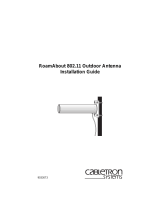Page is loading ...

802.11b PC Card Installation and Specifications
9034062-03
ENJOY THE FREEDOM OF WIRELESS NETWORKING
ENTERASYS.COM
™


Notice
Enterasys Networks
TM
reserves the right to make changes in specifications and other information contained in
this document without prior notice. The reader should in all cases consult Enterasys Networks to determine
whether any such changes have been made.
The hardware, firmware, or software described in this manual is subject to change without notice.
IN NO EVENT SHALL ENTERASYS NETWORKS BE LIABLE FOR ANY INCIDENTAL, INDIRECT,
SPECIAL, OR CONSEQUENTIAL DAMAGES WHATSOEVER (INCLUDING BUT NOT LIMITED TO
LOST PROFITS) ARISING OUT OF OR RELATED TO THIS MANUAL OR THE INFORMATION
CONTAINED IN IT, EVEN IF ENTERASYS NETWORKS HAS BEEN ADVISED OF, KNOWN, OR
SHOULD HAVE KNOWN, THE POSSIBILITY OF SUCH DAMAGES.
© 2003 Enterasys Networks
TM
All rights reserved.
Enterasys Networks, Inc.
35 Industrial Way
Rochester, NH 03867
Part Number: 9034062-03
January 2003
Web Site: www.enterasys.com/wireless
ENTERASYS, ENTERASYS NETWORKS, NETSIGHT, ROAMABOUT, and any logos associated
therewith, are trademarks of Enterasys Networks, Inc. in the United States and other countries.
Microsoft, Windows, and Windows NT are trademarks or registered trademarks of Microsoft Corporation in
the United States and other countries.
PC Card is a trademark of PCMCIA in the United States and other countries.
Apple, the Apple logo, Macintosh, and PowerBook are trademarks or registered trademarks of Apple
Computer, Inc.
LINUX is a trademark of Linus Torvalds.
Red Hat is a registered trademark of Red Hat, Inc.
All other trademarks and registered trademarks are the property of their respective holders.

Regulatory Information
Exposure to Radio Frequency Radiation.
The radiated output power of the IEEE 802.11 RoamAbout PC Card is far below the FCC radio frequency
exposure limits. Nevertheless, the RoamAbout PC Card shall be used in such a manner that the potential for
human contact during normal operation is minimized. When using this device in combination with RoamAbout
Outdoor Antenna products, a certain separation distance between antenna and nearby persons has to be kept to
ensure RF exposure compliance. Refer to the Regulatory Statements as identified in the documentation that comes
with those products for additional information.
Interference Statement.
This equipment has been tested and found to comply with the limits for a Class B digital device, pursuant to Part
15 of the FCC Rules. These limits are designed to provide reasonable protection against harmful interference in a
residential installation.
This equipment generates, uses, and can radiate radio frequency energy. If not installed and used in accordance
with the instructions, it may cause harmful interference to radio communications. However, there is no guarantee
that interference will not occur in a particular installation.
If this equipment does cause harmful interference to radio or television reception, which can be determined by
turning the equipment off and on, the user is encouraged to try to correct the interference by one or more of the
following measures:
• Reorient or relocate the receiving antenna.
• Increase the distance between the equipment and the receiver.
• Connect the equipment to an outlet on a circuit different from that to which the receiver is connected.
• Consult the dealer or an experienced radio or TV technician for help.
Enterasys Networks is not responsible for any radio or television interference caused by unauthorized
modification of the devices included in this kit, or the substitution or attachment of connecting cables and
equipment other then specified by Enterasys Networks. The correction of interference caused by such
unauthorized modification, substitution or attachment will be the responsibility of the user.
For country-specific approvals, please consult the Radio Certification Information document included in this kit.
Visit the RoamAbout Wireless web site for updated country approvals.
Canada - Industry Canada (IC).
This Class B digital apparatus meets all requirements of the Canadian Interference-Causing Equipment
Regulations.
cet appareil de la class B respecte toutes les exigences du Reglement sur le matereil brouiller du Canada

Getting Help
For additional support related to this device or document, contact Enterasys Networks using one of
the following methods:
Before calling Enterasys Networks, please have the following information ready:
• Your Enterasys Networks service contract number
• A description of the problem
• A description of any action(s) already taken to resolve the problem
• The serial and revision numbers of all involved Enterasys Networks products in the network
• A description of your network environment (for example, layout, cable type)
• Network load and frame size at the time of trouble (if known)
• The device history (for example, have you returned the device before, is this a recurring
problem)
• Any previous Return Material Authorization (RMA) numbers
World Wide Web: www.enterasys.com/support
Phone: (603) 332-9400
Internet mail: support@enterasys.com
To send comments or suggestions concerning this document, contact the Enterasys Networks
Technical Writing Department via the following e-mail address: TechWriting@enterasys.com
Make sure you include the document Part Number in the e-mail message.


1
RoamAbout 802.11b PC Card
This document provides the system requirements, installation procedure, and technical
specifications for the RoamAbout 802.11b PC Card.
Before installing the PC Card, please review the Regulatory information included
in the RoamAbout Radio Certification and Regulatory Information document
included with the PC Card.
System Requirements
When you install the RoamAbout PC Card, you must also install its driver. You can also
download the RoamAbout drivers and documentation from the RoamAbout wireless web
site: www.enterasys.com/wireless
Check the RoamAbout wireless web site frequently for driver updates. If you download a
driver from the web, refer to that driver’s release notes and readme file for the instructions
to extract and install the driver. The RoamAbout PC Card Drivers CD-ROM contains the
driver and installation information for the following operating systems.
• The RoamAbout NDIS3 Miniport driver supports Windows 95.
• The RoamAbout NSID4 Miniport driver supports Windows NT V4.0 or later. If you
are using Windows NT V4.0, you also need Service Pack 4 or later.
• The RoamAbout NDIS5 driver supports Windows 98, 2000, Millennium, and XP.
Refer to the RoamAbout wireless web site for additional drivers to support operating
systems such as Linux, Apple, Windows CE, and DOS.
NOTE: The RoamAbout World Card (CSICD) does not support outdoor
antennas (Yagi or omni). For outdoor solutions, use the appropriate PC
Card for your country (CSIBD or CSILD). Contact your Enterasys
Representative.
The Windows 2000 driver included with the operating system does not
support encryption. You must update the driver with the RoamAbout
Windows 2000 driver included on the RoamAbout CD-ROM.

2
PC Card Installation
To install the PC card, perform the following steps:
1. Insert the PC Card in the PC Card slot, if available.
2. If the system does not have a PC Card slot but has an available ISA bus slot, install the
optional ISA adapter card. If the system does not have an ISA slot, install the optional
PCI adapter. The installation instructions are in the ISA adapter kit and the PCI adapter
kit.
Refer to the driver operating system directory readme on the CD-ROM to install the
appropriate driver. Or, if you downloaded the driver, refer to the directory where you
downloaded the files.
E
N
J
O
Y
T
H
E
F
R
E
E
D
O
M
O
F
W
I
R
E
L
E
S
S
N
E
T
W
O
R
K
I
N
G
W
I
R
E
L
E
S
S
L
A
N
S
8
0
2
.1
D
S
H
i
g
h
R
a
te
H
i
-
G
i
g
a
b
i
t
M
a
t
c
h
e
d
A
d
a
p
t
e
r
W
i
F
i

3
Technical Specifications
Radio Characteristics
Consult your authorized RoamAbout reseller sales office for information about the radio
regulations that apply in your country. Table 1 shows the radio characteristics for the
802.11b PC Card.
Table 1: 802.11b Radio Characteristics
Characteristic Value
R-F frequency band 2.4 GHz (2400-2483.5 MHz)
Standards IEEE 802.11b, WiFi Certified
Number of selectable channels for the World Card 11
Number of selectable channels for North America
and countries supporting FCC (Standard Card)
11
Number of selectable channels for Europe and
other countries supporting ETSI
13
Number of selectable channels for Singapore (FR) 4
Number of selectable channels for Japan (JP) 14
Modulation technique Direct sequence spread spectrum
(DQPSK, CCK, DBPSK)
Spreading 11-chip barker sequence
Bit error rate
Better than 10
-5
Receiver sensitivity at 11 Mbit/s -82dBm
Receiver sensitivity at 5.5 Mbit/s -87dBm
Receiver sensitivity at 2 Mbit/s -91dBm
Receiver sensitivity at 1 Mbit/s -94dBm
Nominal output power 15 dBm (CSICD, CSIBD)
8 dBm (CSILD)
Doze Mode 9 mA
Receive Mode 185 mA
Transmit Mode 285 mA
Power Supply 5 V

4
Physical Specifications
Table 2: RoamAbout 802.11b PC Card Physical Specifications
Radio Ranges
Signal strength can be affected by closeness to metal surfaces and solid high-density
materials. The ranges listed in Table 3 provide a general guideline and may vary according
to the actual physical environment where the product is used.
• In open environments, there are no physical obstructions between antennas.
• In semi-open environments, work space is divided by shoulder-height, hollow wall
elements; antennas are at desktop level.
Table 3: 802.11b Radio Ranges
Specification Value
Dimensions (LxWxH) 118 x 54 8 mm (4.72 x 2.26 x 0.32 in)
Weight 45 grams (1.58 oz)
Temperature (Operation)
0
o
to 55
o
C (32
o
to 131
o
F)
Temperature (Transit)
-20
o
to 70
o
C (-4
o
to 158
o
F)
Temperature (Storage)
-10
o
to 60
o
C (14
o
to 140
o
F)
Humidity Maximum 95%, no condensation allowed
Range 11 Mbit/s 5.5 Mbit/s 2 Mbit/s 1 Mbit/s
Open environment 160 m
(525 feet)
270 m
(885 feet)
400 m
(1300 feet)
550 m
(1750 feet)
Semi-open environment 50 m
(165 feet)
70 m
(230 feet)
90 m
(300 feet)
115 m
(375 feet)

5
Supported Frequency Sub-Bands
The RoamAbout PC Card supports a number of factory-programmed channels. The
number of available frequencies is subject to local radio regulations as defined by local
authorities.
In RoamAbout infrastructure environments, the RoamAbout PC Card automatically starts
operation at the frequency channel that is used by the RoamAbout AP. This frequency is
controlled by the LAN administrator who sets the RoamAbout AP configuration. The
frequency range for the RoamAbout 802.11b PC Card is 2400 - 2500 MHz. Table 4 shows
the factory-set default values for the 802.11b PC Card, which are printed in bold.
Table 4: IEEE 802.11b RoamAbout Channel Sets
Product Safety
USA: UL 1950, UL Listed
Canada: CUL 1950
Europe: EN60950
Japan: IEC 950
Channel ID FCC ETSI Singapore Japan
1 2412 2412 - 2412
2 2417 2417 - 2417
3
1
2422
1
The Access Point 2000 uses this channel as the default.
1
2422
-2422
4 2427 2427 - 2427
5 2432 2432 - 2432
6
2
2437
2
The RoamAbout R2 uses this channel as the default.
2
2437
-2437
7 2442 2442 - 2442
8 2447 2447 - 2447
9 2452 2452 - 2452
10 2457 2457 2457 2457
11 2462 2462 2462 2462
12 - 2467 2467 2467
13 - 2472 2472 2472
14 --- 2484

/

